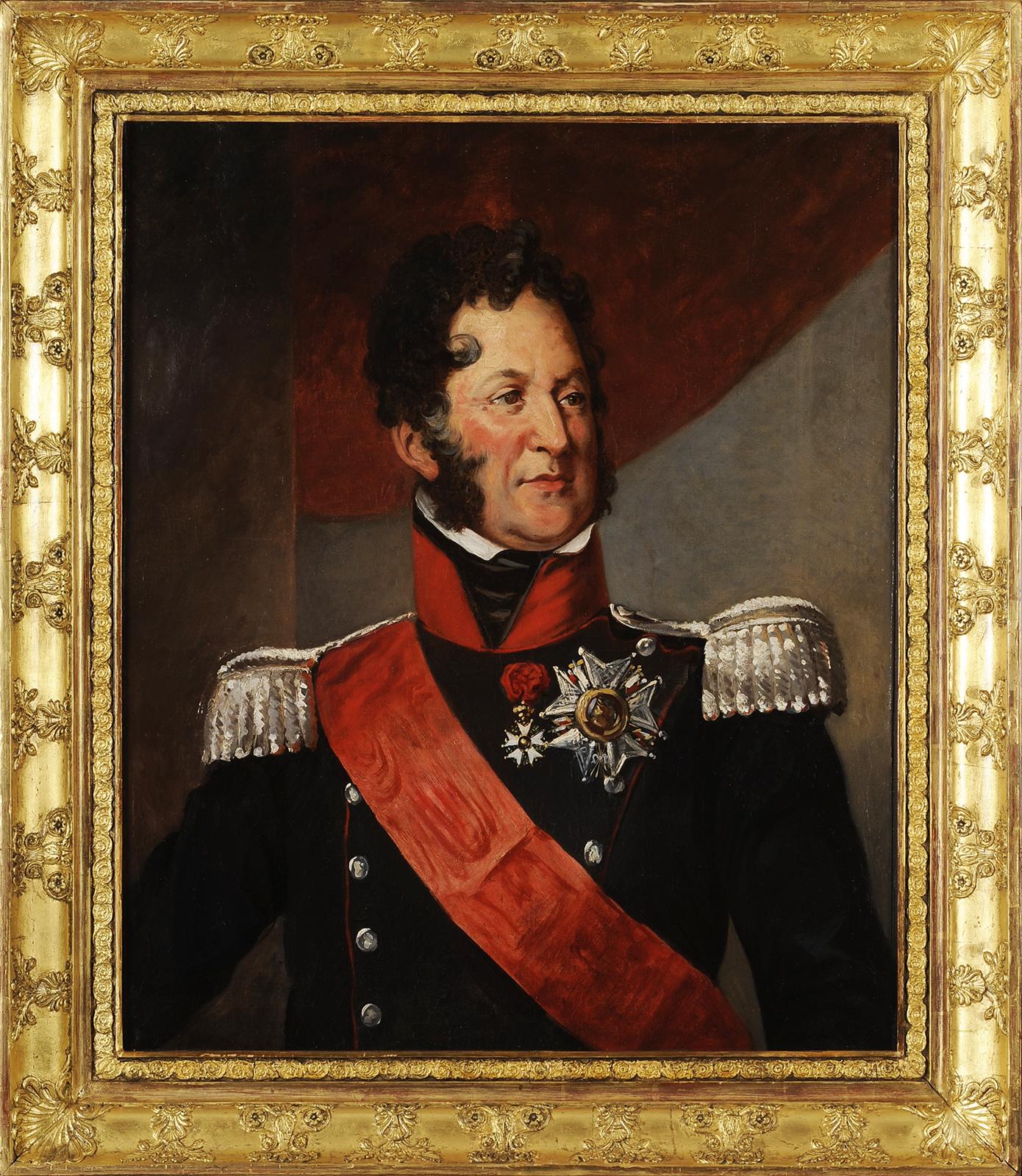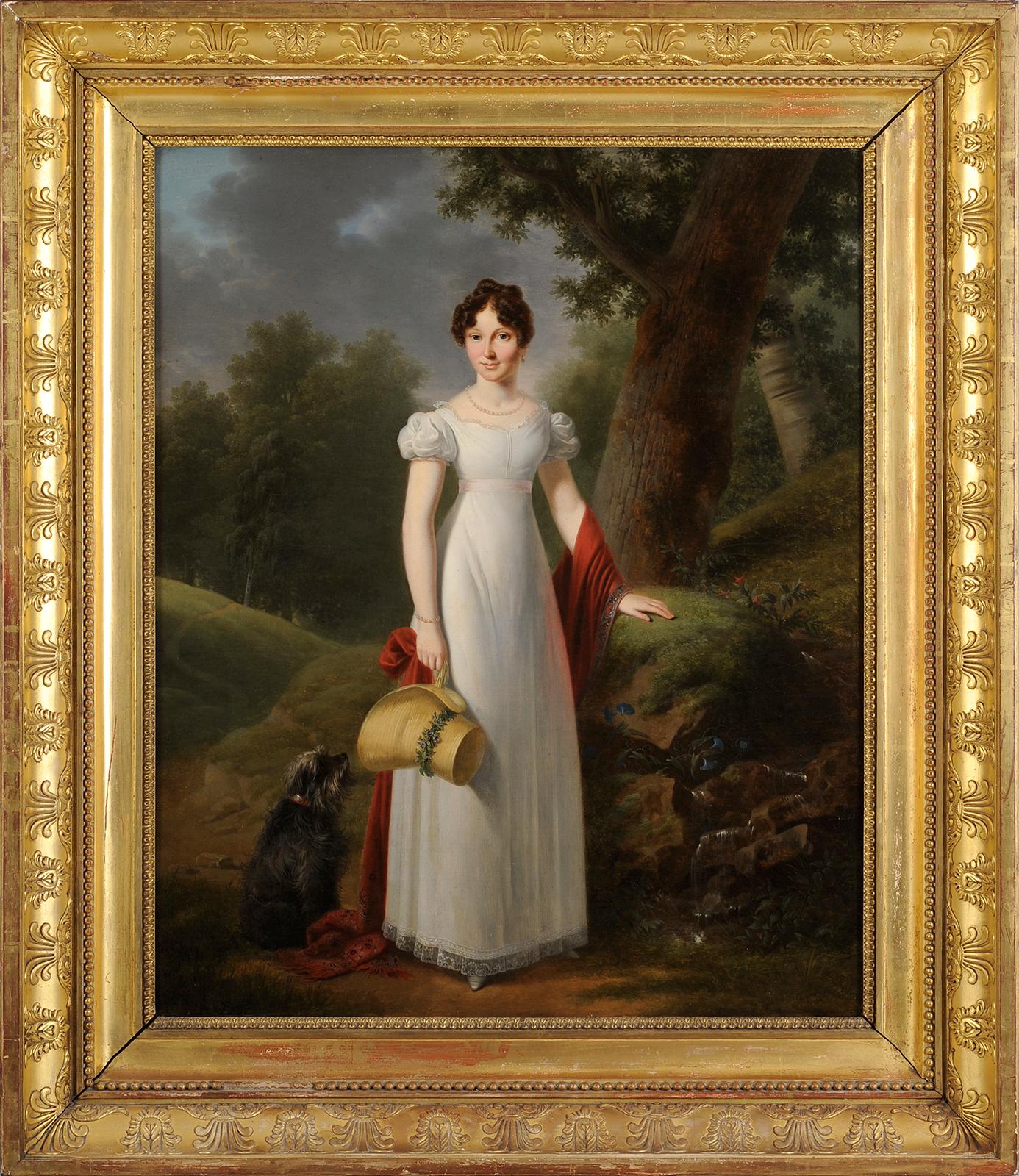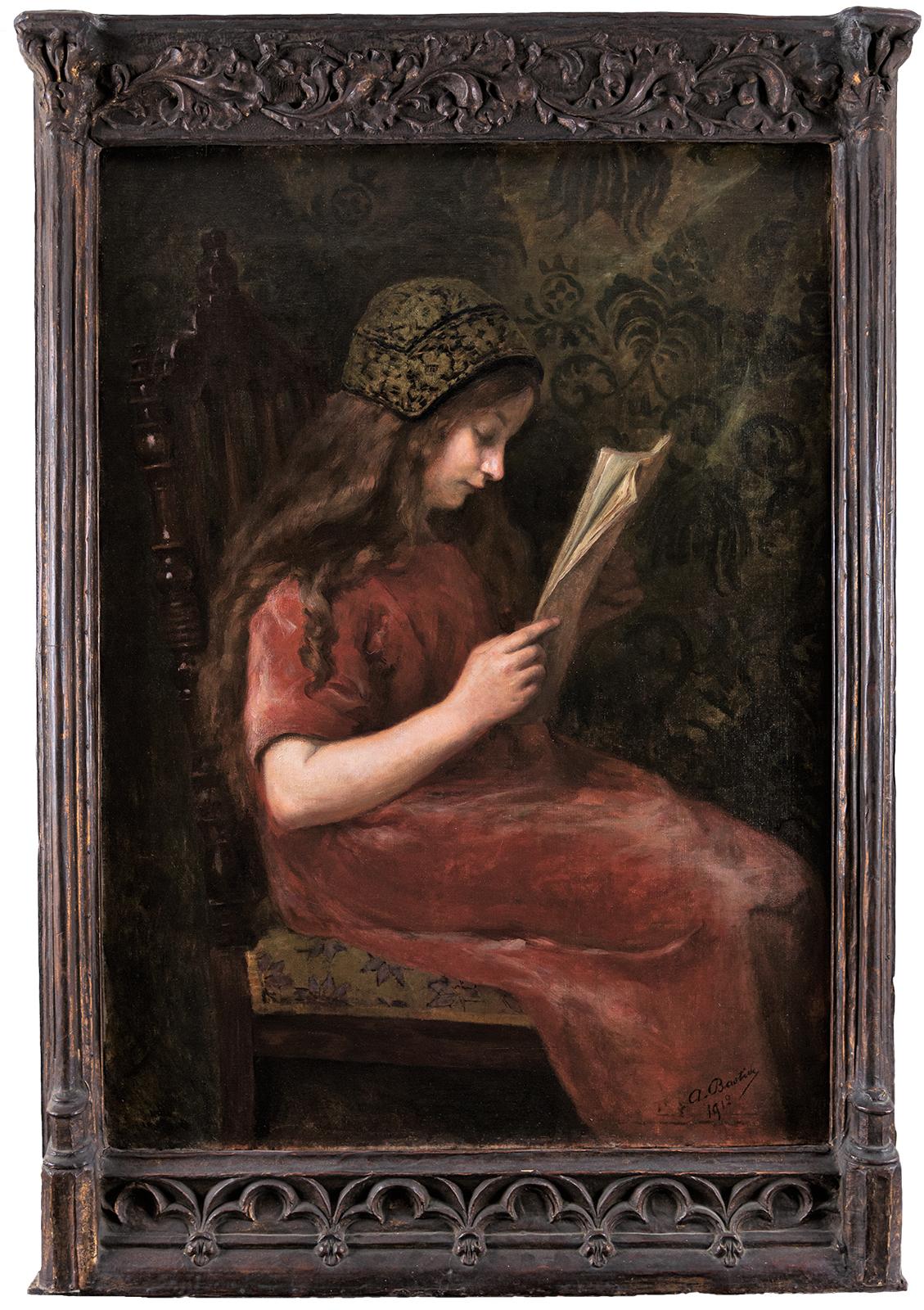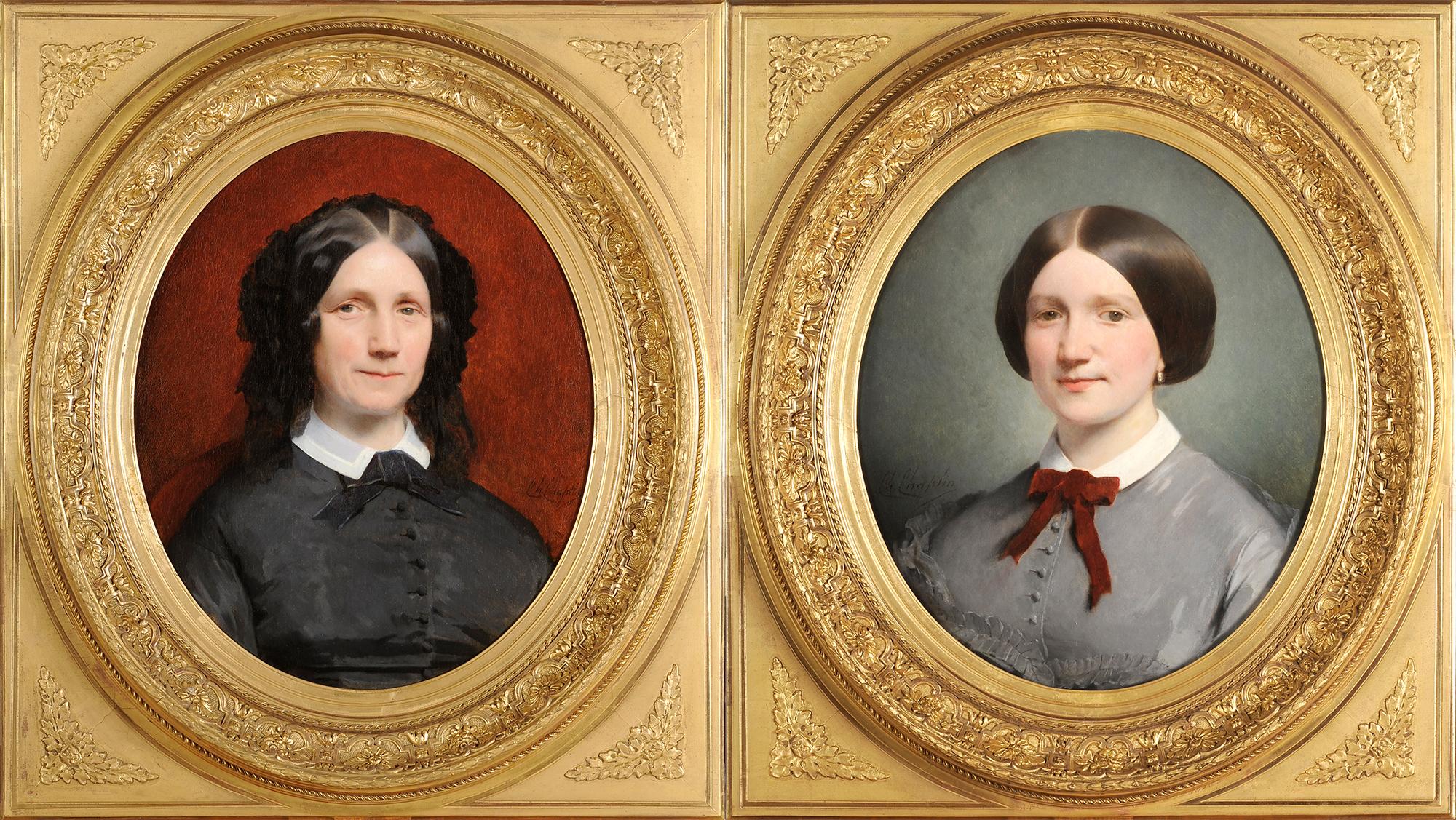Items Similar to Portrait of a woman at the bistro with an Absinthe glass and cigarette
Want more images or videos?
Request additional images or videos from the seller
1 of 8
André DevambezPortrait of a woman at the bistro with an Absinthe glass and cigarettec. 1905
c. 1905
About the Item
André DEVAMBEZ
(Paris, 1867 - Paris, 1944)
Portrait of a woman in a bistro
Oil on mahogany panel
H. 22 cm; L. 16 cm
Signed lower right
Around 1905/1910
Provenance : Galerie de la Scala (68, rue La Boétie, Paris 8th), then by descent
Exhibition : the painting will appear (loan) in the exhibition dedicated to André Devambez by the Rennes Fine Arts Museum (February-May 2022 period) and the Petit-Palais Museum in Paris (September-December 2022 period)
Son of the famous engraver and publisher Édouard Devambez, the young André very early on showed a taste and drawing skills. A pupil of Benjamin Constant and Jules Lefebvre at the Académie Julian, he continued his apprenticeship at the Beaux-Arts in Paris and won the Grand Prix de Rome in 1890, but he had already participated in his first Salon des Artistes Français in 1889. Back in Paris in 1896 after his Roman training, he first collaborated in magazines (L'Illustration or Le Rire for example) with humorous and satirical drawings, and he also illustrated menus, programs, or created posters. But quickly he will make himself known through his paintings. Alongside his large Salon paintings or his compositions for decorations, he developed an intensive production of genre paintings, often filled with tenderness and humour: beach scenes (in Yport) or urban life teeming with small characters (subway platforms, air shows, public gardens, omnibus queues, fairgrounds...), small portraits of drinkers, philosophers, skits with craftsmen, duelists, swordsmen or other brigands. At the time of his first private exhibition in 1913 at the Georges Petit gallery, he had already acquired popular fame and public recognition (legion of honor in 1911, regular participation in the Salon). It is particularly appreciated for its bird's eye viewpoints and its crowd effects. The war, where he was seriously injured, inspired him to paint on this theme, but did not interrupt his success as an unclassifiable artist, with multiple registers of expression. An article in the illustrated monthly Larousse devoted to him in 1930 speaks of the "realism of his figures, the antithesis of conventional academicism...irreproachable and precious execution... heir to the fine traditions of the Dutch and Flemish masters...". Our painting with its strong presence belongs to the series of what Devambez called his Misunderstood (in reference to his painting at the Salon of 1904, Les Misunderstood, now kept at the Quimper museum) and which he was particularly fond of: types of drinkers, poets or artists drowning their distress or seeking inspiration in alcohol, lost philosophers... alone or in groups, inspired by the people of the bistros, in which the consumption of alcohol, in particular absinthe, was so very strong. The art historian Gustave Soulier writes about this: "It's like a kind of new Daumier that we find in Mr. Devambez". Between humor and tragedy, these guys are often decked out in grotesque hats, too big, too small, dented, or of incredible shape like that of our drinker. This one presents a marked face, with premature aging possibly due to the abuse of alcohol and tobacco. Whether she is a simple emancipated woman (there is a painting by Devambez titled La féministe, could it be ours?) smoking her cigarette and drinking her glass alone, or an old prostitute hoping to still be able to attract a hypothetical client, the café seems for her a place of asylum more than a place of exchanges and debates. Our work, by its subject and its construction, can be compared to the painting (27 x 21 cm) kept at the Musée du Petit-Palais in Paris, titled Au Café, and representing an absinthe drinker with a cigarette, supposed to be the chansonnier Marcel Legay.
- Creator:André Devambez (1867 - 1943, French)
- Creation Year:c. 1905
- Dimensions:Height: 36.23 in (92 cm)Width: 28.75 in (73 cm)
- Medium:
- Movement & Style:
- Period:
- Condition:Perfect condition. Cleaned.
- Gallery Location:BELEYMAS, FR
- Reference Number:1stDibs: LU1860214300492
About the Seller
No Reviews Yet
Vetted Seller
These experienced sellers undergo a comprehensive evaluation by our team of in-house experts.
Established in 2011
1stDibs seller since 2022
- ShippingRetrieving quote...Ships From: BELEYMAS, France
- Return PolicyThis item cannot be returned.
More From This SellerView All
- French King Louis-Philippe - After Baron GérardLocated in BELEYMAS, FRAfter Baron Gérard, circa 1835 Portrait of King Louis-Philippe Oil on canvas H. 79 cm; L. 65 cm Provenance : Private collection, Périgord, by descent since the 19th century This po...Category
1830s French School Figurative Paintings
MaterialsCanvas, Oil
- François-Joseph Kinson - Young woman portrait with her dogBy Francois Kinsoen (Kinson)Located in BELEYMAS, FRFrançois-Joseph KINSON (Bruges 1770 – Bruges 1839) Portrait of a young woman near a spring, accompanied by her dog Oil on canvas H. 73 cm; L. 60 cm circa 1815-1817 We owe this elegant portrait to François-Joseph Kinson from Bruges, which is still linked to the art of the First Empire. We find in this artist this type of pose that is a bit rigid, sometimes with a countryside in the background, and this way of treating costumes and faces. Thus the full-length portrait of Jenny...Category
1810s French School Figurative Paintings
MaterialsCanvas, Oil
- French school c.1815 - Portrait of a young boyLocated in BELEYMAS, FRFrench school circa 1815 Portrait of a young boy Oil on canvas H. 84 cm; L. 70 cm Provenance: Señor Valdes Fauri Collection, Madrid around 1900/1950; then Private collection, Bordea...Category
1810s French School Figurative Paintings
MaterialsCanvas, Oil
- Young girl readingLocated in BELEYMAS, FRAlice BASTIDE (Saint Mandé 1868 – Paris 1959) Portrait of a little girl reading Oil on canvas H. 100 cm; L. 72.5 cm Signed lower right and dated 1912 Daughter of a pastor from Gard and an English woman, Alice Bastide grew up in Paris. A pupil of the Jullian Academy, she began her apprenticeship under the guidance of Henri Royer and François Schommer. The development of his art is mainly oriented towards still lifes, without completely abandoning portraits and landscapes. Her other specialty for which she received numerous awards is miniatures. At the Salon of 1914 she received the Maxime David prize crowning the best piece while her finesse was already noticed by press critics from 1907. Coronation, in 1926 she received a gold medal at the Salon for her miniature Coquetterie. In 1896, the young woman married a man from Gard, Auguste Massebiaux, whose name she would occasionally bear. The latter, a lawyer at the Paris Court of Appeal, died in 1910. The couple had no children. At that time she was domiciled at 48 avenue d'Orléans (later named avenue du general Leclerc) in Paris where she lived until her death in 1959. Until the mid-1930s she continued to exhibit at the Salon des Artistes French with a manner very close to Impressionism, luminous and vigorous. In 1912, two years after the death of her husband, Alice Bastide was certainly still marked by the sadness of her mourning. The tones of our portrait of a little girl and the frame she puts together are dark and heavy. This child, wearing an embroidered bonnet, is bent over her book, her loose hair flowing over a red velvet indoor dress. This intimate portrait on a dark tapestry...Category
1910s French School Figurative Paintings
MaterialsCanvas, Oil
- Sketch of a dandy portraitLocated in BELEYMAS, FRFrench school circa 1840 Sketch of a dandy portrait Oil on canvas mounted on cardboard H. 21 cm; L. 20.5 cmCategory
1830s French School Figurative Paintings
MaterialsCanvas, Oil
- Pair of women portraitsBy Charles ChaplinLocated in BELEYMAS, FRCharles CHAPLIN (Les Andelys 1825 – Paris, 1891) Portraits of women Pair of oils on rectangular canvases H. 60 cm; L. 50 cm Signed Student of Michel Martin Drolling at the École des...Category
1850s French School Figurative Paintings
MaterialsCanvas, Oil
You May Also Like
- Souvenir from Italy: Pifferaro playing the zampogna with the familyLocated in PARIS, FRJoseph BEAUME (Marseille, 1796 – Paris, 1885) Souvenir from Italy: pifferaro playing the zampogna with the family Oil on canvas Signed lower left 73.5 x 60 cm Provenance: probably...Category
Mid-19th Century French School Figurative Paintings
MaterialsOil
- Portrait of a child with blue eyesBy Charles Zacharie LandelleLocated in PARIS, FRCharles Zacharie LANDELLE (Laval, 1821 – Chennevières/Marne, 1908) Portrait of a child with blue eyes Oil on canvas Monogrammed and dated lower l...Category
Mid-19th Century French School Portrait Paintings
MaterialsOil
- The death of General Négrier on Place de la Bastille, Paris - FranceBy Nicolas Edward GabéLocated in PARIS, FRNicolas Edward GABE (Paris, 1814 - Paris, 1865) The death of General Négrier on Place de la Bastille on June 25, 1848 Oil on canvas Signed and dated lower right 82 x 101 cm 1849 Nicolas Edward Gabé is a 19th century artist who is still little studied to this day and yet seems to have enjoyed, according to the artistic press of the time, a certain notoriety, in particular for his seascapes. The few bibliographical elements that we have come from the Salon booklets and tell us that the artist was born in Paris in 1814, therefore shortly before the end of the Empire. No elements on his artistic training are mentioned in the booklets, we just know that Gabé exhibited at the Paris Salon from 1835 to 1864 where he first practiced miniature then then approached easel painting, risking himself as well in still life that the seascapes, the landscape, the portrait or the hunting. According to press articles, he also took part in various exhibitions in the provinces such as Boulogne-sur-Mer and Marseille. Notably, Gabé did not exhibit at the Salon his large historical canvases on the revolution of 1848, which today are of obvious documentary and iconographic interest; probably for political reasons which are easily understandable to us today in view of the historical events of then. Gabé died in Paris at the age of 51 on January 4, 1865 with a mention in the January 7, 1865 edition of L'Union des Arts: “The death of Mr. Gabé, painter, well known in the export trade in paintings as well as to the auctioneers' hotel, whose sales it supplied through its numerous navies. “ "On June 25, 1848, in front of the barricades erected in the Bastille by the insurgents of the Red Republic, General Négrier fell to death, while he was uttering words of order and conciliation". Here are the opening lines of the tribute paid by Colonel Borgarelli d´Ison, friend of General Négrier. General Négrier belonged to a family from Maine, brought back by Marshal Lannes from emigration. Born in Le Mans on April 27, 1788, François Marie Casimir de Négrier entered, barely 18, as a volunteer in the 2nd Light Infantry Regiment. He began in 1806 with the campaigns of Prussia and Poland, during which he earned, through his bravery, the rank of sergeant and the decoration of the Legion of Honor. He made the following campaigns in Spain and Portugal, and left, with his regiment, only for the campaign of France, in 1814, after having risen successively, by actions of brilliance and by a serious wound, to the ranks of head of battalion and officer of the Legion of Honor, with which he was provided from October 1813. The Restoration retained his rank in his regiment. After having fought and wounded a second time seriously in Waterloo, Négrier was recalled in 1816 under the second Restoration. He was appointed, in 1825, lieutenant-colonel, then colonel in 1830, brigadier general in 1836, and of division in 1841. From March 1837 he participated in the conquest of Algeria. The Revolution of 1848 found Negrier in possession of the important command of the 16th Military Division in Lille. Quaestor of the Assembly in these times which promised to be troubled, Négrier reviewed the Place de la Concorde on June 23 at around noon various mobile guard battalions. He then took the head of 2,000 men provided by the 10th and 11th legions of the national guard and bivouacked on the Place du Palais until the next day 24. On Sunday 25 at nine o'clock, the Négrier division resumed the fight towards the Saint suburb. -Antoine. The troop gains continual advantages. At around two o'clock the column of Négrier had seized the Pont Marie: it had removed the barricades from the Quai Saint-Paul, the rue de l'Etoile, the rue des Barres...Category
Mid-19th Century French School Figurative Paintings
MaterialsOil
- Presumed portrait of Athanase Peltier in front of the Fort of Ham - FranceLocated in PARIS, FRÉdouard Henri Théophile PINGRET (Saint-Quentin, 1785 – Paris, 1869) Presumed portrait of Athanase Peltier in front of the Fort of Ham Oil on canvas Signed and dated lower left 40.5...Category
Early 19th Century French School Portrait Paintings
MaterialsOil
- Blue macaw perched on a branchBy Jean-Baptiste OudryLocated in PARIS, FRFrench school of the second half of the 19th century, follower of Oudry Blue macaw perched on a branch Oil on canvas 73 x 60 cmCategory
Late 19th Century French School Portrait Paintings
MaterialsOil
- Portrait of Marie Despagne in front of Chartres Cathedral, FranceLocated in PARIS, FRVictor FAVIER (Versailles, 1824 – Nice?, After 1889) Portrait of Marie Amarante Guibée, wife Despagne in front of Chartres cathedral Oil on canvas Signed and dated 58 x 41 cm 1849 ...Category
Mid-19th Century French School Figurative Paintings
MaterialsOil





